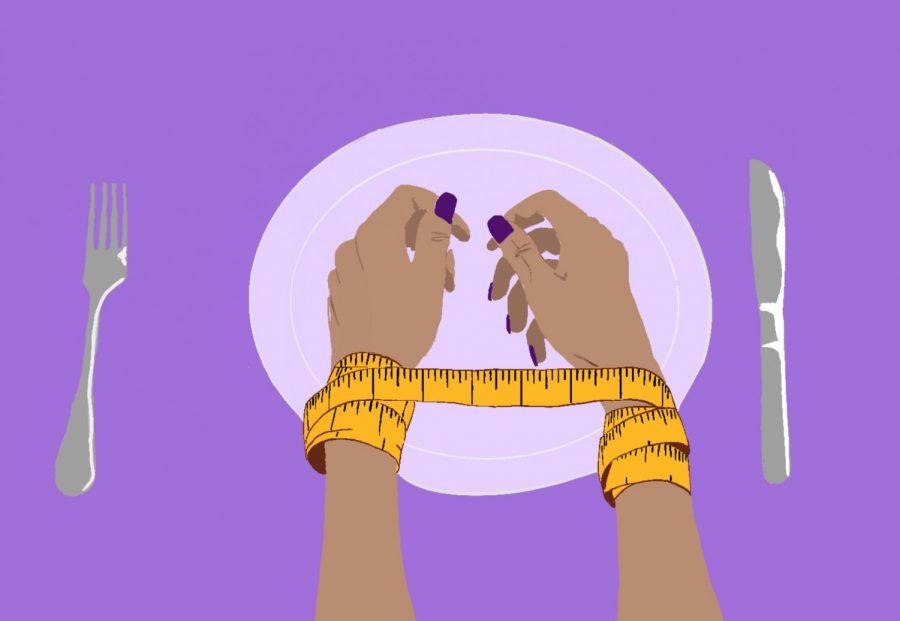Out of Control: An Honest Conversation About Eating Disorders in Teens
October 28, 2022
The Covid-19 pandemic negatively impacted the world as a whole in very different ways. Not a day went by when the news wasn’t reporting about the infamous epidemic. Unfortunately, there was another epidemic on the rise that everyone failed to see. Eating Disorders.
Oxford dictionary defines an eating disorder as “Any of a range of psychological disorders characterized by abnormal or disturbed eating habits.”
A recent report done by the CDC showed an alarming increase in hospitalizations and mental health visits among those suffering from an Eating Disorder. From the isolation, anxiety, and depression that the pandemic caused, it’s understandable how the disruption of daily routine and life could cause an Eating Disorder to develop, or cause a relapse in someone’s recovery. Except, according to the regional clinical director for the Eating Recovery Center and Pathlight Mood & Anxiety Center in the Texas Region, Allison Chase, Eating Disorders have been skyrocketing long before the Covid-19 pandemic. “Eating disorders can develop anytime. When you add COVID stress and uncertainty to the mix, the combination can be disastrous,” said Chase.
The Eating Disorder, Anorexia, has become more and more common since the 1960s. The popularity of supermodel Lesley Hornby, nicknamed “Twiggy” due to her ultra-thin appearance created the trend of a stick-thin doe-eyed type look that became the envy of young girls all throughout the world for years. Throughout the next few decades, especially during the 90s, models became thinner, and girls everywhere became more insecure.

Of course, it’s impossible to place the blame for rising eating disorders on a specific model or trend. But there is no denying that the amount of media that is fed to not only teenagers but adults as well shows impossible standards of beauty that can drive them into an eating disorder. This generation lives in a media-saturated world, and it’s impossible to control the message. Social media puts an extreme amount of pressure to meet certain standards of beauty which can lead to a poor body image and an eating disorder.
It’s important to realize that Anorexia is not the only Eating Disorder that someone can develop. Binge Eating Disorder and Bulimia have become almost if not more common than Anorexia. What’s truly terrifying about these illnesses is that they can affect anyone. Women or men, young or old, stick thin or obese, it’s easy for anyone to develop an Eating Disorder.
A study done by NEDA (Nation Eating Disorder Association) in 2007 found that Binge Eating Disorder also known as “BED” was more common than breast cancer and schizophrenia. They also found that 3.5% of women and 2.0% of men have dealt with Binge Eating Disorder during their life, making it more common than Anorexia and Bulimia combined. And it can be just as dangerous. Symptoms of BED are weight gain, increased risk of heart failure, cancer, and low energy.

While not as common, Bulimia is just as dangerous as Anorexia and Binge Eating Disorder. According to the National Association of Anorexia Nervosa and Associated Disorders, eating disorders such as bulimia are the most fatal mental conditions in the United States. This fact is attributed to long-term health problems, as well as suicide. Bulimia can permanently damage your stomach and intestines, causing other problems like constipation, diarrhea, and irritable bowel syndrome.
As previously mentioned, it’s no secret Eating Disorders are a worldwide epidemic. But what can be done to stop them from spreading?
Unfortunately, not much can be done to stop the overall spread of Eating Disorders. Especially with the mass influence of toxic diet culture that lives on apps like Instagram and Tiktok. However, there are many ways an individual can seek help or treatment for themselves.
“A good first step is to contact an eating disorders treatment facility that has various levels of treatment – residential and outpatient – as its staff can assess your symptoms and let you know what type of care is appropriate,” said Kimberly M. Daniels, a clinical psychologist in Hartford, Connecticut, who specializes in eating disorders.
Along with professional help, there are many coping mechanisms one can use such as,
- Prioritizing your own mental and physical health.
- Challenging negative self-talk – for instance, “I’m not good enough” or “I’ll never be able to do this.”
- Filling your life with positive activities.
- Grow your support system. The point is to find safe people to help you feel supported in recovery.
If you or someone you know is suffering from an Eating Disorder please call or text (800) 931-2237 or contact a local healthcare provider.


































